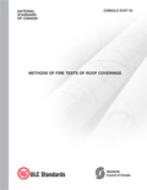
Click here to purchase
The test methods described in this Standard are applicable to roof covering materials and are intended to measure the relative fire-performance characteristics of roof coverings when exposed to fire originating from sources outside a building on which they may be installed. They are applicable to roof coverings intended for installation on either combustible or non-combustible decks when applied as intended for use.
Three classes of fire test exposure are described in this Standard.
Class A – Tests are applicable to roof coverings that are effective against severe fire exposures, are not readily flammable, afford a fairly high degree of fire protection to the roof deck, do not slip from position and are not expected to produce flying brands.
Class B – Tests are applicable to roof coverings that are effective against moderate fire exposures, are not readily flammable, afford a moderate degree of fire protection to the roof deck, do not slip from position and are not expected to produce flying brands.
Class C Tests are applicable to roof coverings that are effective against light fire exposures, are not readily flammable, afford a measurable degree of fire protection to the roof deck, do not slip from position and are not expected to produce flying brands.
It is the intent that the classifications indicate performance during tests of the types of materials and periods of exposure involved, and should not be construed as having any significance with respect to the suitability for use after fire exposure.
Roof covering materials are required to comply also with other requirements for construction, material specifications, and performance as applicable to specific types, designs, sizes and arrangements. All such additional requirements are not considered to be within the scope of these requirements for fire tests.
Product Details
- Edition:
- 3
- Published:
- 2010
